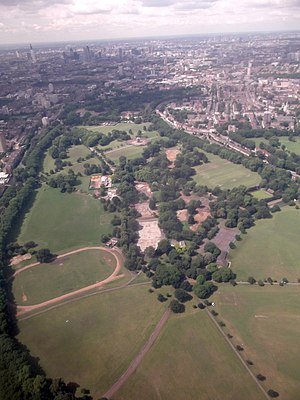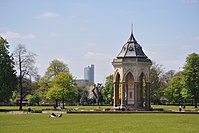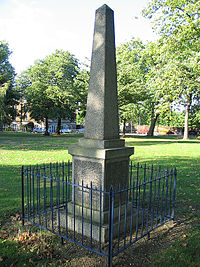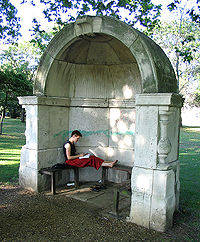Victoria Park, Middlesex: Difference between revisions
mNo edit summary |
m ioe -> nhle, replaced: {{IoE|42629 → {{NHLE|1124208, {{IoE|426300 → {{NHLE|1235619 |
||
| Line 15: | Line 15: | ||
[[File:Victoria Park proposal 1841.jpg|right|thumb|300px|A drawing of the proposed layout published in 1841]] | [[File:Victoria Park proposal 1841.jpg|right|thumb|300px|A drawing of the proposed layout published in 1841]] | ||
Two pedestrian alcoves, surviving fragments of the old [[London Bridge]], demolished in 1831, are located at the east end of the park near the [[Hackney Wick]] war memorial where they were placed in 1860. They were part of the 1760 refurbishment of the 600-year-old bridge, by Sir Robert Taylor and George Dance the Younger, and provided protection for pedestrians on the narrow carriageway. The insignia of the Bridge Association can be seen inside these alcoves. The alcoves have been Grade II listed, since 1951.<ref>{{ | Two pedestrian alcoves, surviving fragments of the old [[London Bridge]], demolished in 1831, are located at the east end of the park near the [[Hackney Wick]] war memorial where they were placed in 1860. They were part of the 1760 refurbishment of the 600-year-old bridge, by Sir Robert Taylor and George Dance the Younger, and provided protection for pedestrians on the narrow carriageway. The insignia of the Bridge Association can be seen inside these alcoves. The alcoves have been Grade II listed, since 1951.<ref>{{NHLE|1235619|Alcoves in Victoria Park}}</ref> | ||
The Lido opened in 1936<ref>{{cite news|publisher=The Times|date=18 May 1936|page=11|title="East London's Lido" £25,000 Swimming Bath Opened}}</ref> and reopened in 1952 following damage during the Second World War; it was closed in 1986 and demolished in 1990.<ref>[http://hackneycitizen.co.uk/2010/11/07/victoria-park-hackney-history/ Victoria Park: a history] – ''The Hackney Citizen Newspaper'' 7 November 2010</ref> | The Lido opened in 1936<ref>{{cite news|publisher=The Times|date=18 May 1936|page=11|title="East London's Lido" £25,000 Swimming Bath Opened}}</ref> and reopened in 1952 following damage during the Second World War; it was closed in 1986 and demolished in 1990.<ref>[http://hackneycitizen.co.uk/2010/11/07/victoria-park-hackney-history/ Victoria Park: a history] – ''The Hackney Citizen Newspaper'' 7 November 2010</ref> | ||
| Line 28: | Line 28: | ||
[[File:Victoria Park fountain.jpg|right|thumb|200px|Baroness Burdett-Coutts drinking fountain]] | [[File:Victoria Park fountain.jpg|right|thumb|200px|Baroness Burdett-Coutts drinking fountain]] | ||
A fountain was erected in the park by the philanthropist Angela Georgina Burdett-Coutts in 1862.<ref>{{ | A fountain was erected in the park by the philanthropist Angela Georgina Burdett-Coutts in 1862.<ref>{{NHLE|11242089|Fountain in Victoria Park}}</ref> | ||
This description by J. H. Rosney, correspondent for ''Harper's Magazine'' (February 1888) evokes a scene: | This description by J. H. Rosney, correspondent for ''Harper's Magazine'' (February 1888) evokes a scene: | ||
Latest revision as of 11:00, 19 September 2019

Victoria Park (known colloquially as Vicky Park or the People's Park) is a park in Bow[1] in eastern Middlesex. The park is 213 acres of open space that opened in 1845. It stretches out across part of the East End of London, bordering parts of Bethnal Green, South Hackney, Cambridge Heath and Old Ford, such as along Old Ford Road, London and Victoria Park Road.
The park has two cafés, The Pavilion Café in the West and The Park Cafe in the East. There are two playgrounds, one on either side of the park, as well as sporting facilities and a skatepark[2] in the East. The park is home to many historic artefacts and features and has decorative gardens and wilder natural areas as well as open grass lands. Victoria Park is also used as a concert venue and hosts many festivals each year. The park is approximately a mile away from the Queen Elizabeth Olympic Park. Owing to its proximity to the Olympic Park, it became a venue for the BT London Live event along with Hyde Park during the London 2012 Olympic Games.
The park has in recent years gone through a 12 million pound refurbishment and many of the park's old features have been reinstated or repaired. It has won the Green Flag People's Choice Award for the most popular public green space in 2012, 2014 and 2015.
The park is Grade-II* listed on the Register of Historic Parks and Gardens.[3]
Origins
The Crown Estate purchased 218 acres which were laid out by notable London planner and architect Sir James Pennethorne between 1842 and 1846. A part of the area was known as Bonner Fields, after Bishop Bonner, the last lord of the manor of Stepney. The land had originally been parkland, associated with the Bishop's Palace, but by the mid-1800s had been spoiled by the extraction of gravel, and clay for bricks.
It was opened to the public in 1845. This large park is reminiscent of Regent's Park (not least because the latter was designed by Pennethorne's teacher John Nash), though much less busy, and is considered by some as the finest park in the East End. It is bounded on two sides by canals: the Regent's Canal lies to the west, while its branch, once known as the Hertford Union Canal runs along the Southern edge of the park. There is a gate named after Edmund Bonner. Guarding the main entrance at Sewardstone Road are replica statues of the Dogs of Alcibiades, the originals of which stood here from 1912 to 2009 until vandalism led to their being removed, restored and rehoused elsewhere in the Park.

Two pedestrian alcoves, surviving fragments of the old London Bridge, demolished in 1831, are located at the east end of the park near the Hackney Wick war memorial where they were placed in 1860. They were part of the 1760 refurbishment of the 600-year-old bridge, by Sir Robert Taylor and George Dance the Younger, and provided protection for pedestrians on the narrow carriageway. The insignia of the Bridge Association can be seen inside these alcoves. The alcoves have been Grade II listed, since 1951.[4]
The Lido opened in 1936[5] and reopened in 1952 following damage during the Second World War; it was closed in 1986 and demolished in 1990.[6]
The People's Park

In the latter half of the 19th Century, Victoria Park became an essential amenity for the working classes of the East End. For some East End children in the 1880s, this may have been the only large stretch of uninterrupted greenery they ever encountered. Facilities like the Bathing Pond (picture right) —later superseded by the park lido—would have introduced many to swimming in an era when many public baths (like that at Shacklewell) were still simply communal washing facilities.
Victoria Park's reputation as the 'People's Park' grew as it became a centre for political meetings and rallies of all stripes, perhaps exceeding in importance the more well-known Hyde Park in this regard. The park occupies the interface between the East End , sunk in poverty in the 19th century and a bed of revolutionary ferment, and the more genteel homes of Hackney, heir to a centuries-old legacy of religious dissent and non-conformism that led to its own fierce brand of reformism. Numerous Speaker's Corners arose in the park in this atmosphere.
Although any one could set up their own soapbox, the biggest crowds were usually drawn to 'star' socialist speakers such as William Morris and Annie Besant.

A fountain was erected in the park by the philanthropist Angela Georgina Burdett-Coutts in 1862.[7]
This description by J. H. Rosney, correspondent for Harper's Magazine (February 1888) evokes a scene:
On the big central lawn are scattered numerous groups, some of which are very closely packed. Almost all the religious sects of England and all the political and social parties are preaching their ideas and disputing [...]On this lawn the listener, as his fancy prompts him, may assist on Malthusianism, atheism, agnosticism, secularism, Calvinism, socialism, anarchism, Salvationism, Darwinism, and even, in exceptional cases, Swedenborgianism and Mormonism. I once heard there a prophet, a man who professed to be inspired by the Holy Ghost; but this prophet ended by being locked up in an asylum, where he will have to convert the doctor before he can recover his liberty.[8]
The tradition of public speaking in the park continued until well after the Second World War, and was still later reflected in politically oriented rock concerts, such as those held by Rock Against Racism and the Anti-Nazi League in the 1970s and 1980s. And it is still not uncommon for marches or demonstrations to begin or end in Victoria Park.
On 26 June 2014, a campaign to revive the Speakers' Corner at Victoria Park was launched at a democratic theatre event held in Shoreditch Town Hall. Hosted by The People Speak,[9] a participatory campaign and events group, 66 audience members deliberated over how to use the pooled cash revenue from their tickets,[10] and eventually voted to recreate the well-known tradition of free speech and debate in Hyde Park in East London's Victoria Park. The campaign is due to formally launch in July 2014.
Second World War

During the Second World War, Victoria Park was largely closed to the public and effectively became one huge Ack-Ack (anti-aircraft) site. The gun emplacements conveniently straddled the path of German Luftwaffe bombers looping north-west after attacking the docks and warehouses further south and so the park was of some strategic importance.
Prisoner of war camps were erected along the north eastern edge parallel to Victoria Park Road and were used to house both Germans and Italians. An air raid shelter was built underground just inside St Marks Gate. On 15 October 1940 a bomb made a direct hit, trapping around a hundred inside and killing fifteen. Much of the park was taken to be used as part of the war effort, which much of the earth being used for allotments, military stations and barrage balloon sites, even the park railings were melted down to be re-used.
The war destroyed many of the park's beautiful early features, three lodges including the Bonner Lodge were completely reduced to rubble. The palm house was shattered, St Augustine's Church collapsed in on itself and the pagoda, moorish shelter and lido were all damaged. With finances tight after the war ended these were sadly torn down rather than repaired.
Modern times

In recent times, Victoria Park became noted for its open-air music festivals, often linked with a political cause. In 1978, Rock Against Racism organised a protest event against growth of far-right organisations such as the National Front. The concert was played by The Clash, Steel Pulse, X-Ray Spex, The Ruts, Sham 69, Generation X, and the Tom Robinson Band. [11] The 1980 rock docudrama Rude Boy features The Clash playing at an Anti-Nazi League event in the park. Radiohead played two concerts in the park on 24–25 June 2008. Madness (band)|Madness celebrated their 30th year with a fifth Madstock there on 17 July 2009. The park has also become very popular amongst dance music's biggest names; Dutch DJ Tiësto played at Victoria Park in 2009 and again in 2010.[12] On 24–25 July 2010, Victoria Park was the site of the first High Voltage Festival. Victoria Park has also hosted Field Day, The Apple Cart, Underage Festival and Lovebox Festival.
For children, Victoria Park is host to: a One O'Clock Club for under-fives and a programme of summer activities and a children's play park including a paddling pool that runs from 1-5pm in the summer months.
The oldest model boat club in the world,[13] the Victoria Model Steam Boat Club, founded in the Park on 15 July 1904, is still active today and holds up to 17 of their Sunday regattas a year. The VMSB Club runs straight-running boats just as they did 100 years ago but have also progressed to radio controlled boats and hydroplanes. The first Regatta is traditionally held on Easter Sunday and the Steam Regatta is always held on the first Sunday in July.
The Park is also the home of Tower Hamlets Football Club and Victoria Park United Football club, Tower Hamlets Cricket Club, Victoria Park Harriers & Tower Hamlets Athletics Club, which has its headquarters at St Augustine's Hall located at the north-east corner of the Park. The Club celebrated its 80th Anniversary in 2006.
During the summer cricket is played every evening on the park's three all-weather wickets, organised by the Victoria Park Community Cricket League. The park also has a popular three-lane cricket net, free to use at all times. It was refurbished to a high standard at the end of 2005, paid for by a grant from the England and Wales Cricket Board.
The park is open daily from 6:00am to dusk.

In 2010 the National Lottery Big Lottery Fund awarded the London Borough of Tower Hamlets a £4.5 million grant towards a £12 million programme of major improvements to Victoria Park.[12][14] Plans included a new building, the Eastern Hub, comprising a cafe, public toilets, community rooms and adult play facilities to promote healthy living.
The landscape has been restored in many places, and the Old English gardens restored to include new water features. In 1842 a pagoda was put in London's Hyde Park as an entrance to its Chinese Exhibit, and when the exhibit finished it was moved to Victoria Park's island in the west boating lake for ornamental purposes. The original architect for the park, Pennethorne, designed a bridge to the island that matched the style of the pagoda; this was never built, however, and during WW2 the pagoda suffered much damage.
The pagoda was eventually demolished in the 1950s and all but forgotten, while the water surrounding the island was filled in, shrinking the lake and making what was the island part of the park landscape. With the parks refurbishments that began in 2010 it was decided to restore the island to its former glory; the lake was extended back around the original area, the pagoda was replicated through the use of many photographs and eye-witness information and then, to complete Pennethorne's unfinished vision, the plans for his original bridge were discovered and the bridge built. It took over 100 years, but Pennethorne's vision was finally completed. As a finishing touch, pedallos and row boats were brought back on to the West lake, a feature which had been missing from the park for decades.

The Burdett-Coutts fountain (named after Angela Burdett-Coutts the Victorian philanthropist) had a partial restoration of its intricate granite carvings and sculptures. In recent years the fountain had been fenced off due to graffiti and vandalism, but along with the restoration the fences were removed, and four symmetrical mirror pools were placed around the fountain along with decorative flower beds. The area is now a public space, with many benches offering an attractive place to sit.
A modern addition to the park is the Memoryscape trail, an audio trail winding through the park that visitors listen to using headphones. The trail consists of many historical facts and tidbits of information, and includes accounts from people who grew up in and around the park, with one person for example reminiscing about the prisoner of war camp in the park during World War 2. Visitors can either download the tracks from the council's website and put them on their own device, or they can get a pair of pre-loaded headphones from the hub in exchange for a small refundable deposit.
Outside links
| ("Wikimedia Commons" has material about Victoria Park, Middlesex) |
- Location map: 51°32’13"N, 0°2’17"W
- Park Café (East Side)
- Pavilion Café (West Side)
- Tower Hamlets Football Club
- Victoria Park Community Cricket League
- Victoria Park Harriers & Tower Hamlets Athletics Club
References
- ↑ Victoria Park
- ↑ Victoria Park Skatepark – The Skateparks Project
- ↑ National Heritage List 1000178: Victoria Park
- ↑ National Heritage List 1235619: Alcoves in Victoria Park
- ↑ ""East London's Lido" £25,000 Swimming Bath Opened". The Times. 18 May 1936. p. 11.
- ↑ Victoria Park: a history – The Hackney Citizen Newspaper 7 November 2010
- ↑ National Heritage List 11242089: Fountain in Victoria Park
- ↑ J. H. Rosney, "Socialism in London", III, (in Googlebooks facsimile of Harper's New Monthly Magazine, vol. LXXVI), February, 1888, pp. 412 & 414
- ↑ "The People Speak". The People Speak. http://thepeoplespeak.org.uk/. Retrieved 2017-06-10.
- ↑ "Upcoming Events - ‘Who Wants to Be..?’ Lift Festival 2014 – Change for a tenner! – The People Speak". Thepeoplespeak.org.uk. 2014-06-26. http://thepeoplespeak.org.uk/event/who-wants-to-be-lift-festival-2014-change-for-a-tenner/. Retrieved 2017-06-10.
- ↑ "The Rock Against Racism rallies 1978: Victoria Park april 1978". http://www.ukrockfestivals.com/victoria-park-1978.html. Retrieved 2017-04-03.
- ↑ 12.0 12.1 Music Review: Tiësto/Pendulum @ Victoria Park, londonist.com, 3 August 2010
- ↑ Guinness Book of Records
- ↑ £9million bumper boost for the people’s parks of London, Big Lottery Fund. Accessed 27 September 2011.
- A Pictorial History of Victoria Park, London E3. Published by the East London History Society, ISBN 0-9506258-1-7
